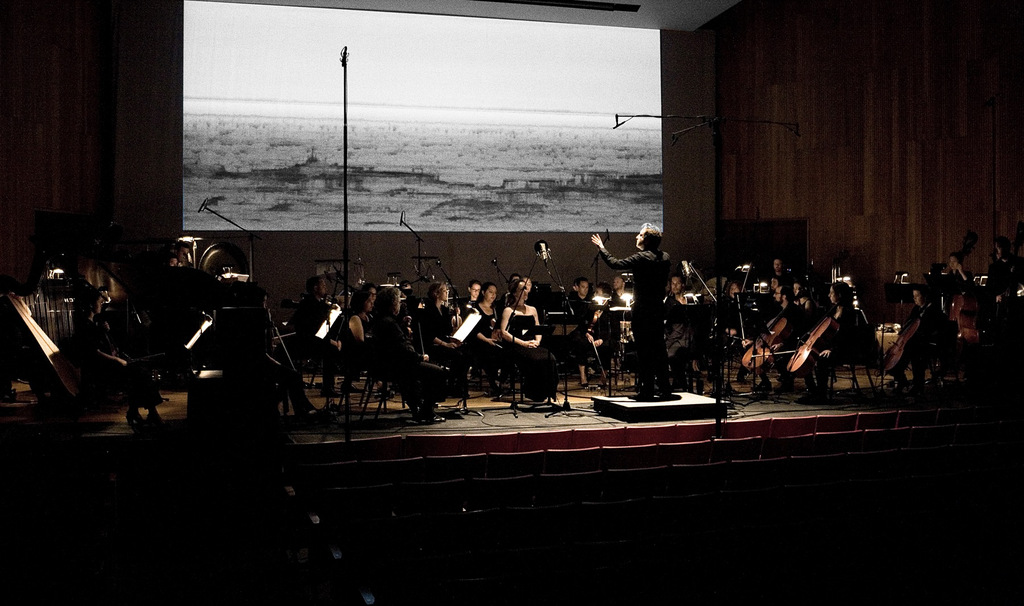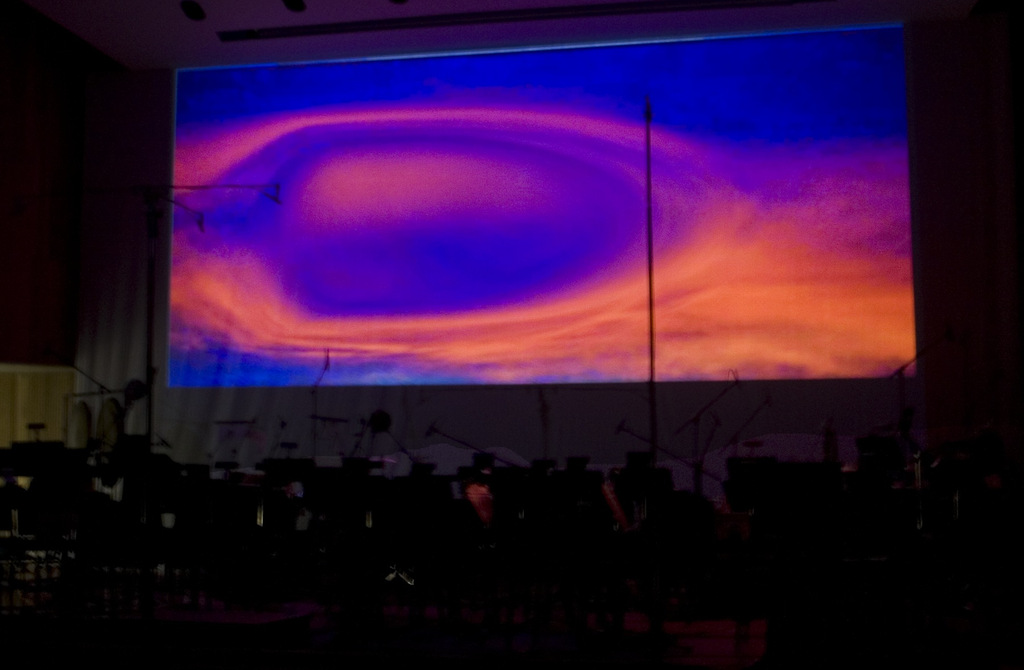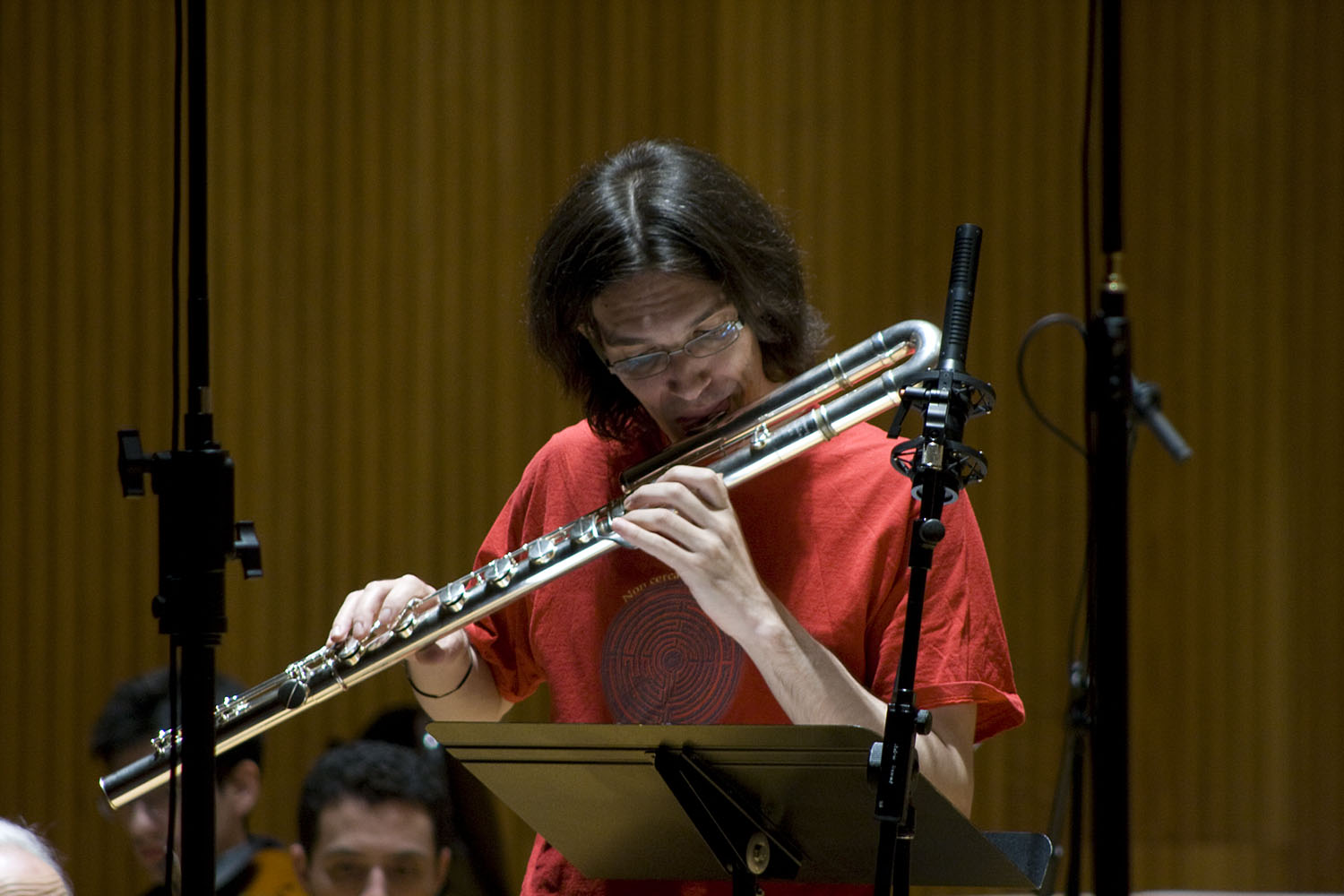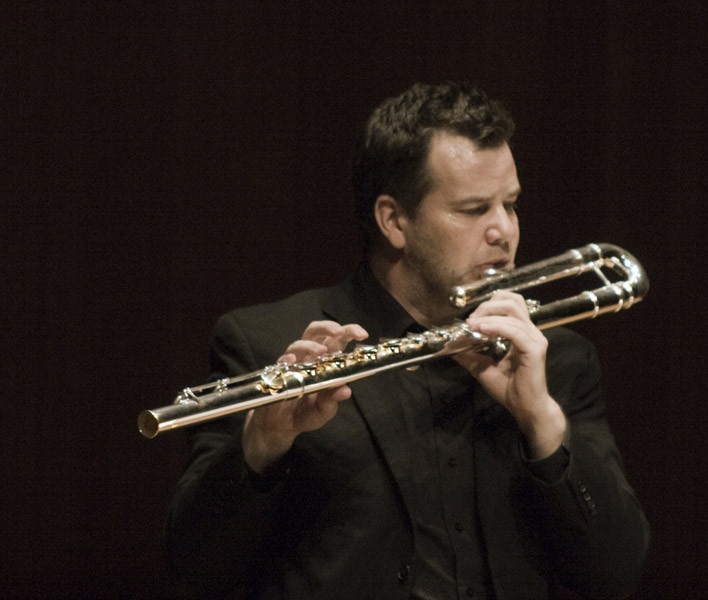News & Reviews
Les Quatre Temps Cardinaux
-
All the pieces in Sunday's concert […] might have inspired the title 'Surround Sound,' but it was the Felder work that made it literally true, bouncing electronic sounds and samples around an array of speakers located throughout the auditorium. To call Felder's Les Quatre Temps Cardinaux 'electronics-enhanced' would be like calling Brahms's First Symphony 'horn-enhanced.' The electronics were so integral to this ambitious, 50-minute-long meditation on time that they became a third soloist, taking over entirely from the orchestra at several points in extended solo cadenzas.
-
David Felder's Les Quatre Temps Cardinaux of 2013 was the symphonic-length conclusion to Sunday's program. It's a fiercely ambitious work, employing soprano and bass soloists (here, Laura Aikin and Ethan Herschenfeld), and weaving together poetic texts by René Daumal, Robert Creeley, and others, by turns sung, heard in recorded recitation, and abstracted into pure sound. At one point, for instance, we hear all the vowels of a poem strung together without any consonants. Felder deploys his vastly expanded palette of sounds artfully. In Sunday's account, the human voice of the poetry introduced a kind of melancholy undercurrent beneath the whir of the orchestral machine.
-
Of the three works on Sunday's program, David Felder's Les Quatre Temps Cardinaux took best advantage of the surround-sound stereo set-up in the hall. […] Throughout, the blend of electronic and acoustic sounds is virtually seamless. The orchestral writing is generally colorful and vigorous, nowhere more so than in Felder's dazzling painting of a sunrise in its opening section. The ferocious climax at the end of Part 2 was also thrilling, but for another reason: it let the orchestra really rip for the first time all afternoon.
-
The poems [in Felder's Les Quatre Temps Cardinaux] are heard not only in the spiky, emotionally intense vocal writing, but spoken on the recorded tracks, which also include percussion sounds and the sparkle, buzz and variegated growl of purely electronic timbres, all moving around a dozen speakers placed throughout the hall. Abstract video by Olivier Pasquet added atmosphere rather than commentary. All this could easily have become an exhibition of gimmickry, but Mr. Felder kept his grand audio-visual fabric focused, sober and often wrenching.






Stuck-Stücke
-
Some of the most high-octane music of the afternoon, though, came in David Felder's Stuck-stücke for String Quartet. Exploding out of the gate, it rarely pulled back from edge-of-the-seat intensity throughout its 13 short movements, with violinist Ari Streisfeld leading a performance that left scorch marks on the ears.



Inner Sky
-
The most technologically advanced undertaking of the festival was Inner Sky, complex and geogeously scored.
-
Inner Sky was a highlight of the festival; and Three Pieces for Orchestra's profound forward-pointing poetry ended the festival.
-
David Felder's Inner Sky [is] a bracing, ravishing soundscape for flutes (Marie Tachouet), electronics, and ensemble (led by Fellow Robert Treviño)
-
David Felder's electronic sounds magnified the already eerie orchestral scoring in Inner Sky (1994-99), though the main focus was the flute line (more precisely, piccolo, alto, bass and standard flute lines), which Marie Tachouet played with extraordinary agility.
-
Inner Sky is an immersive listening experience. It's also a highly sophisticated colloquy between soloist, ensemble, and electronics; one that achieves a carefully choreographed balance of elements, both acoustic and musical: a balance that is all too rarely found in works for orchestra plus electronics. It certainly helped to have Tachouet's sensitive performance and Robert Treviño's fine direction of the Tanglewood Music Center Orchestra.






Canzone XXXI
-
David Felder's Canzone XXXI stood in marked contrast even though from common roots (3 previous Venetian canzoni). Based on Dante's grief-laden Canzone on the death of Beatrice, Felder's piece is tightly written, muted at first and passing from snarling to more open as the mutes came off. Episodic in form, and with multiple peaks of intensity, the music is uncompromisingly modern and complex. It is not so much flagrantly dissonant as simply not consonant and needs several hearings in order to become accustomed to its language.



Six Poems from Neruda's Alturas...
-
Elegance has a place of its own. A piece was played which would be most interesting to hear again in thirty years when it is time to pick a piece to be performed as representative of this year's (1995) I.S.C.M. The American composer David Felder's Six Poems...was extremely elegant varying between explosive energy and austere lyricism, and at the same time so skillfully written that it brought Richard Strauss to mind--if one can imagine a Strauss who landed in today's swarming city life.
-
A far greater inventiveness and even a true personal expression characterized the American, David Felder's music. His Six Poems...is difficult to describe: melodic, but not melodious, rhythmic but only with a clear pulse in the highly original last movement, intangible, yet substantial, especially in the long, elegiac middle movement which is surrounded by the two riotous outer movements.
-
Chilean poet Pablo Neruda's verse (Six Poems from Neruda's "Alturas...") is a disturbing view of many social issues and humankind's continual struggle to cope. Felder, while not attempting literal portrayals, does capture the flavor of uncertainty in his gestural music. The first and shorter movement is an environment obsessed with pell-mell forward impetus. It sounds chaotic at first, but if you stay with it, an order and a strong dramatic profile emerge. The music has an overriding feverish quality which is very well projected via turbulent sometimes jumbled lines and effective percussion bursts. This is music which may be harsh and gritty, but clearly has a mind of its own and is definitely going somewhere. The longer second movement lies in quiet linear expressions in the strings with subtle wind sub texts colored by some extraordinary percussion effects. This continual, intimate unfolding of musical thoughts is suffused with a subtle beauty and guided by a sense of logic which makes the relatively consonant concluding string chord absolutely right. On second hearing (April 7), Felder's music made the same strong impression. All that remains now is for the Philharmonic to record this work.

November Sky
-
In November Sky the flute is commanded to go forth and multiply, the flute's basic gestures cataloged and isolated, and then made to grow, shrink, tighten and expand. The soloist on stage in this quasi-concerto for flute and flutes was Jayn Rosenfeld. She made her way through four members of the instrument's immediate family, from piccolo to bass while loudspeakers on either side alternately shrieked, cooed, and groaned in response
-
There is much variety in Felder's music, as well as originality; one might not think these five pieces came from the same composer, yet one would certainly have a hard time putting another's name to them. Journal achieves shining textures, with dissonances used to punctuate a basically consonant setting; it begins with energy and settles into serenity. Three Lines begins quietly and ruminates for much of the piece; then comes a tough harsh outburst, followed by an intriguing coda. November Sky retains an ethereal, ecstatic quality throughout. The performances are all first rate and the recordings are brilliant. Felder has proven an original composer who takes a lot of chances and usually wins.
-
The principal concert, given by the Buffalo Philharmonic at the end of the week , was devoted to just two twenty-minute pieces-Mr. Felder's percussion concerto Between and Mr. Wuorinen's "Bamboula Squared". It was good to be able to hear two major pieces by him(Felder): November Sky, a duet for flutist and computer, descending from piccolo screams to the cool dark of the bass flute, as well as the percussion concerto. Both works showed the importance to a composer of being around performers [...] Rachel Rudich was the intensely active performer of November Sky; Steve Schick worked with athletic speed and grace on a battery of instruments frontstage in Between [...] The eventual orchestral performances were compelling and often beautiful.



BoxMan (for Trombone)
-
Earlier in the same adventurous program (1989 Huddersfield), was David Felder's Crossfire described as 'a music and video virtuoso performance project for solo musician and video projection'. Part 1, Another Face featured a dazzling violin solo while two banks of over thirty video screens reflected images of a performer dancing. Part 2, BoxMan concerned itself with a supra-real, Gothic-sized trombonist; described in the program as 'entirely self-referential' it also represents a curious and massive ego trip for the performer who is both heard live and seen in many dimensions on the screens.
-
Even more fun came when trombonist Anderson sat flanked by loud speakers and nested within the wires and pedals of David Felder's 'mini-opera,' BoxMan. The richly fascinating variety of sounds Anderson got was quite enough of a good thing. The opening solo was something that Bill Harris of the old Thundering Herd would have admired, wild and full...
-
BoxMan was as constricting in its psychological context as it was expansive in its technical complexity. Trombonist Miles Anderson put his horn through a variety of different effects, interacting with pitch dividers, digital delays, sampled portions of his own playing and a video wall display that cut up his image and dealt it out in a wild shuffle. Anderson played his declamatory role with relish, filling the hall with wailing, gut-wrenching tones which were delayed and played back forming an eerie claustrophobic canon. Like any technical innovation in the arts, Felder's live interactive music-video promised novelty, but proved to be a sharper scalpel for the dissection of the self.
-
BoxMan was the artistic high point of the festival (Ars Electronica, 1987, Linz Austria) as a whole. The evolution of such an impressive work happened in two ways: the composition by David Felder, which used elements of jazz and the soundscapes of new music was phenomenally interpreted by the excellent trombonist Miles Anderson and was woven into synthesized sounds. A precious rarity happened, namely a truly convincing symbiosis of natural and digitalized sound. A piece of music of dynamic power, tender sensibility, and vital humor. The work found congenial visual interpretation through the clearly defined aesthetics of the video wall. Through fluid, rapidly changing images, the trombonist was mirrored by his interpretation as well as his interior states. And this in a perfect harmony of real-time and pre-produced video. A wholly credible artwork in music and visuals, and therefore, in both realms a promise for the future.

Another Face
-
Earlier in the same adventurous program (1989 Huddersfield), was David Felder's Crossfire described as 'a music and video virtuoso performance project for solo musician and video projection'. Part 1, Another Face featured a dazzling violin solo while two banks of over thirty video screens reflected images of a performer dancing. Part 2, BoxMan concerned itself with a supra-real, Gothic-sized trombonist; described in the program as 'entirely self-referential' it also represents a curious and massive ego trip for the performer who is both heard live and seen in many dimensions on the screens.
-
Another Face could easily have sunk into mere sound effects, a boring and ultimately meaningless exploration of all the sounds a solo violin can make. But the underlying lyricism and sheer bravura of (Chicago Symphony Orchestra's concertmaster, Robert) Chen's performance took us on the psychological journey that Felder envisioned.


Three Pieces for Orchestra
-
Felder's Three Pieces for Orchestra is loosely based upon episodes from the composer's experience. The outer movements are dense yet form a purposeful continuum that clearly is going somewhere. This is music with an epic reach, cosmic energy, and unconcern with the commonplace, The central movement, however, is a study in sonority, open textures, and spare orchestral colorations, largely in slower, measured statements with a more reflective ambience. Heralding horns make thematic suggestions that never develop but give the form useful reference points. Summoning brass and timpani usher in the final movement, which resumes the character of the first movement, but is punctuated by interior exclamations and melodic fragments concluding with massive percussion hammer blows.
-
Inner Sky was a highlight of the festival; and Three Pieces for Orchestra's profound forward-pointing poetry ended the festival.
Linebacker Music
-
Felder's brief Linebacker Music was linked with Stravinsky's Rite in that they both evoke feelings of ferocity, even savagery: and on the technical level, they are built not so much on the idea of themes as onelemental motifs and recurring rhythmic phrases that can be so compelling as to have the memorability of full-fledged themes. Don't expect Linebacker Music to remind you of 'The Blue Danube'. Wholly consistent with its subject matter, it has a very declamatory opening, then proceeds to be stridently aggressive and percussion-laced, and to convey a feeling of massive strength at all times, even in a brief, quiet section.It resemble "Pacific 231", an acknowledged mini-masterpiece, in its driving insistence.
Journal
-
There is much variety in Felder's music, as well as originality; one might not think these five pieces came from the same composer, yet one would certainly have a hard time putting another's name to them. Journal achieves shining textures, with dissonances used to punctuate a basically consonant setting; it begins with energy and settles into serenity. Three Lines begins quietly and ruminates for much of the piece; then comes a tough harsh outburst, followed by an intriguing coda. November Sky retains an ethereal, ecstatic quality throughout. The performances are all first rate and the recordings are brilliant. Felder has proven an original composer who takes a lot of chances and usually wins.
-
David Felder's Journal was, to this listener, the most effective of the three commissioned works [...]. The work didn't sound very lyrical at the outset, but during the course of ten minutes or so, Felder has created a poignant, spirit-filled, almost serene tone poem. "Journal" is well scored. There is no chaos here with each instrument clearly audible and contributing to the sense of the ensemble, yet still retaining its individuality. Rather, there is a strong sense of coming together as the music unfolds.
Between
-
Felder's Between is a riveting score [...] There's some gorgeous orchestral writing here - the use of percussion and soloist Steve Schick's virtuosity being the pervasive if not dominant feature. The pulsating basses evoke drama building to double mallet toccata-like frenzy with bass drum shots falling like mortars. With nicely engineered transitions, this is a schizophrenic tone-poem, its seeming incoherence part and parcel of its power.
-
The principal concert, given by the Buffalo Philharmonic at the end of the week , was devoted to just two twenty-minute pieces-Mr. Felder's percussion concerto Between and Mr. Wuorinen's "Bamboula Squared". It was good to be able to hear two major pieces by him(Felder): November Sky, a duet for flutist and computer, descending from piccolo screams to the cool dark of the bass flute, as well as the percussion concerto. Both works showed the importance to a composer of being around performers [...] Rachel Rudich was the intensely active performer of November Sky; Steve Schick worked with athletic speed and grace on a battery of instruments frontstage in Between [...] The eventual orchestral performances were compelling and often beautiful.
Third Face
-
Third Face, by David Felder, a composer on the faculty, was brief--ten minutes--and eventful. I have not heard much Felder music, but what I have heard has been exciting; the (New York) Philharmonic should look at his Three Lines from Twenty Poems, which the Buffalo Philharmonic played last year. After the concert, I was tempted to follow the Arditti across the border to hear the Felder again when it was played in Toronto that evening...
-
One of the most ambitious programs of the season was that heard at a Group for Contemporary Music concert last week. It consisted of four very demanding- and rewarding- string quartets by Jonathon Harvey, Wayne Peterson, David Felder, and Stefan Wolpe [...] The four works were very different from one another; in idiom, technically, emotionally, in musical purpose. But in common they demonstrated the continuing vitality of the medium to which for more than two centuries composers have entrusted some of their highest, strangest, noblest thoughts [...] Peterson and Felder are American composers unknown to American Grove Dictionary, but not to American audiences; and Felder and Cage were the American composers honored at last year's Huddersfield Festival [...] Felder's Third Face was given its first performance by the Arditti, at the 1988 Buffalo new music festival. I was struck by it then; after further hearings of it I admire it even more. It is lucid, but with a controlled wildness in its making. Written for virtuosi, it challenges them by presenting its fierce, fertile ideas with almost reckless rhythmic and dynamic exuberance.
-
Felder's Third Face alternates between a muscular, interlocking quartet of instrumental jeremiads, and more delicate alignments in whispering harmonics. It's a tense, hard-fisted work, extravagant in its rhetoric, full of howls and leering virtuoso licks.
Three Lines from Twenty Poems
-
Felder's Three Lines from Twenty Poems was excellently crafted and very communicative, opening with quietly descending orchestral sighs in bitonal language followed by a long diatribe of heaving, brass-topped cacophony from which the anguished bursts of trombone sound could be repeatedly heard within the tumultuous orchestral texture. This gradually trailed off to a few plaintive and bare solo cello lines answered by percussive popping sounds.
-
There is much variety in Felder's music, as well as originality; one might not think these five pieces came from the same composer, yet one would certainly have a hard time putting another's name to them. Journal achieves shining textures, with dissonances used to punctuate a basically consonant setting; it begins with energy and settles into serenity. Three Lines begins quietly and ruminates for much of the piece; then comes a tough harsh outburst, followed by an intriguing coda. November Sky retains an ethereal, ecstatic quality throughout. The performances are all first rate and the recordings are brilliant. Felder has proven an original composer who takes a lot of chances and usually wins.
Crossfire
-
Charm is not the word that springs immediately to mind when contemplating the powerful visions of David Felder's Crossfire. Karen Bentley's elegant and powerful violin, and trombonist Barrie Webb's awesome stunning power coupled with the stark video images made a powerful impact [...]'What a Show!'
-
Earlier in the same adventurous program (1989 Huddersfield), was David Felder's Crossfire described as 'a music and video virtuoso performance project for solo musician and video projection'. Part 1, Another Face featured a dazzling violin solo while two banks of over thirty video screens reflected images of a performer dancing. Part 2, BoxMan concerned itself with a supra-real, Gothic-sized trombonist; described in the program as 'entirely self-referential' it also represents a curious and massive ego trip for the performer who is both heard live and seen in many dimensions on the screens.
Colección Nocturna (orchestral version)
-
Felder was conductor in his Coleccion Nocturna after a poem by the Chilean poet Pablo Neruda in which the composer felt 'powerfully evocative images of a surreal nocturnal landscape...' He scored the work for clarinet/bass clarinet and piano soloists, tape and orchestra. Neruda's poem contains a phrase, 'I am rent by the shock of my dreaming', which reflects the quality of this music. The clarinet is alternately lyrical, then used as the shrill leading edge of massed sonorities. Orchestral textures are generally quite dense but the strings were often given surprisingly consonant supporting chordal passages. Four loud speakers bracketed the hall, the tape tracks used not as a major element but to shadow the solo instruments or for heightening effect. It seemed a series of advancing and receding waves which reached for and achieved the same kind of ecstatic ambiance, at its peaks, that Ruggles' "Men and Mountains" is capable.
Colección Nocturna (chamber version)
-
Mr. Felder's powerful Coleccion Nocturna, a 1983 work for piano and clarinet was the polar opposite of the Feldman. Extroverted and kinetic, sometimes harmonically spiky sometimes sweetly lyrical, it demanded a more conventional virtuosity. Jean Kopperud's agile clarinet playing and her ability to move easily between graceful, song like lines and brash passages full of leaps and incongruities served Mr. Felder's music well.
-
David Felder's affecting Coleccion Nocturna took its title from a Pablo Neruda poem, and presumably its shadowy, searching mood as well. The poem itself describes "a hard intonation of darkness," which Mr. Felder ably transcribed for clarinet, piano and tape, in a work that stood out for its highly emotive writing and direct, visceral style. Jean Kopperud played both clarinet and bass clarinet with fluid technique and expressive urgency. She was vividly complemented by the pianist Christopher Oldfather.
Rocket Summer
-
Rocket Summer, a solo piano work slightly more difficult in approachability than the remainder of the concert, was full of close-knit, furiously accelerating and crescendoing interwoven trills and repeated notes, very dense; contrasted with crystalline sounds, cold and stabbing, seeming almost a study in light rather than sound. Yvar Mikhashoff played it wonderfully.